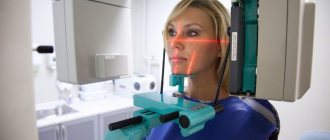Sometimes women come to the gynecologist with the question: “After an x-ray, when can you get pregnant?” After all, X-ray radiation is not harmless for the expectant mother. Many responsible women understand this and try to delay pregnancy after an x-ray. But there are situations when pregnancy occurs unexpectedly. The woman recalls that she recently (perhaps even in the current cycle) had an x-ray and is now worried about how the radiation will affect the baby’s health.
Let's talk to experts about how long it takes to get pregnant after an x-ray and whether there are reasons to panic.
Planning and x-ray
Any married couple wants to give birth to an absolutely healthy baby. And those future parents who take this issue seriously understand that they need to prepare for this important step in advance.
Planning a pregnancy is an important and responsible activity that involves a number of procedures aimed at identifying possible deviations from the norm in the bodies of future parents.
An X-ray examination may be prescribed by a doctor in the following cases:
- When diagnosing the cause when pregnancy does not occur for a long time;
- A routine fluorographic examination of the lungs, which every person must undergo once a year;
- Photograph of teeth during oral sanitation;
- For injuries;
- For some diseases, when ultrasound diagnostics are not enough.
And it often happens that a woman does not yet know that she is pregnant when she receives a certain dose of radiation.
When can you plan to conceive after an x-ray? Will pregnancy proceed with complications after an x-ray? Can irradiation affect the fetus; will it have developmental defects after this procedure? Let's look at these important issues.
The need for x-rays before pregnancy
An X-ray examination performed during pregnancy planning may be needed in different cases. For example, in the absence of fluorography. It may be required at work if this period coincides with the next preventive medical examination. Or the expectant mother simply has not undergone such an examination for a long time, and now, in preparation for conception, she will have to do it.
Another option for x-ray examination is dental treatment. Before pregnancy, it is advisable to carry out a complete sanitation of the oral cavity to exclude foci of infection. Often during dental treatment, especially in cases of dental problems, it is necessary to take an x-ray.
There are situations when, in order to undergo a full examination before conception, the doctor, in addition to directions for tests, prescribes an X-ray examination of the abdominal organs. This procedure is especially necessary when you need to check the patency of the fallopian tubes.
Is it possible to get pregnant immediately after hysterosalpingography?
When planning a pregnancy, the doctor will definitely prescribe an X-ray if the long-awaited conception does not occur for a long time. The test is called hysterosalpingography (HSG). It must be carried out in order to determine the quality of patency of the fallopian tubes. If adhesions are found in the tubes, fertilization is impossible.
To check whether the tubes are patent, an HSG is performed, during which a contrast agent is used. It is with its help that you can see in the pictures the condition of the pelvic organs. Thanks to this procedure, the doctor can also detect formations that are dangerous to the woman’s health.
An interesting fact is that after completing this study, a woman who has not been able to get pregnant for a long time may discover two cherished stripes.
There is a completely scientific explanation for this “miraculous” healing. The same liquid used for X-rays is injected under pressure. The result of this procedure is the divergence of small adhesions and restoration of the patency of the fallopian tubes.
This important point must be taken into account after the x-ray, and your doctor will tell you when you can become pregnant. But in any case, during the menstrual cycle when the woman was examined, she needs to use protection, since the egg received a serious dose of radiation.
X-ray of fallopian tubes before conception
If you have not been able to get pregnant up to this point, your doctor may suggest obstruction of the fallopian tubes. And in this case, an x-ray examination must be carried out. After all, it is this factor that determines whether the long-awaited pregnancy will occur or not. If there is an adhesive process in the tubes, then there may be no talk of fertilization for now.
The doctor can find out what condition the fallopian tubes are in only after an x-ray. This procedure is carried out using a contrast agent, which allows you to display the condition of the pelvic organs on the pictures. In addition to the patency of the tubes, an X-ray examination provides information about the presence or absence of fibroids, polyps and other formations, which is of great importance not only for the health of the unborn child, but also for the woman herself.
Quite often it happens that after conducting such a study, a woman becomes pregnant.
There is an explanation for this. The contrast liquid used for the procedure, injected under pressure, promotes the divergence of adhesions. As a result, the patency of the fallopian tubes can be restored.

This point must be taken into account when planning pregnancy and going through a similar process. Conception should not be allowed to occur during the same menstrual cycle, since the egg has received a large amount of radiation exposure. What do we have to do? If an x-ray is scheduled for the middle of the cycle or the last third (it happens that you can get pregnant during this period), then you should take care of pregnancy protection at this time, despite the great desire to have a child.
What if pregnancy has already occurred?
Everyone knows that X-ray radiation in large doses can be harmful to health. But modern equipment reduces the harmful effects of the procedure to a minimum.
If the risk is minimal, is it possible to take x-rays immediately before conception and during pregnancy? Most gynecologists agree that it is undesirable for a pregnant woman to undergo this procedure. It is prescribed only in cases of extreme necessity.

With strong (and especially repeated) irradiation, living tissue cells can be harmed:
- Cells are damaged and are unable to perform their functions fully;
- Transform into forms of malignant formations;
- They die off.
The cells of the reproductive system are considered the most vulnerable to radiation. Irradiated sperm in men and damaged eggs in women are unable to conceive.
It is for this reason that the organs of the reproductive system must be protected using lead screens when undergoing an X-ray examination.
Since each organism has its own characteristics and reacts individually to any influence, the unborn child should be protected from the negative consequences of radiation.
It is worth planning conception two menstrual cycles after the body has received a dose of radiation - this is a sufficient period of time even for “reinsurers”.
However, many gynecologists are confident that it is possible to plan conception for the next cycle after the x-ray.
Can you trust the equipment?
Today, modern digital equipment is used to conduct radiographic examinations. This, of course, does not eliminate X-rays, but many doctors believe that minimal radiation received after the procedure will not cause any harm when planning a pregnancy. In addition, X-ray itself is a fairly informative diagnostic method that allows you to identify many pathologies, so it should not be ignored.
However, many, especially people of the older generation, are sure that after an x-ray, the unborn child may develop various pathologies and developmental anomalies. However, if there is no child yet, where will they come from? If you are very worried about the upcoming fluorography or dental x-ray examination, then you can ask the doctor for a protective apron. By the way, they give it anyway, especially when conducting examinations using old-style equipment. Individual X-ray protection equipment is used during the study.
Effect on the fetus: doctors' opinions
Sometimes a woman, after undergoing an x-ray examination, finds out that she was already pregnant at that time. And she is very concerned about whether this procedure affects the development of the fetus.
Doctors have different opinions about the safety of X-rays for expectant mothers.
Some doctors believe that modern equipment helps reduce risks to a minimum. Therefore, future parents have nothing to worry about.
Another part of the doctors claims that there are risks of complications. However, the consequences depend on what kind of examination was carried out and to what extent.
The risk of complications depends on how early the x-ray was taken.

If a woman was examined in the first half of the cycle, then there is no need to worry. After all, at this time the egg has not yet had time to mature and be released.
Having received irradiation in the second half of the menstrual cycle, when ovulation has already occurred, there is a high probability that the fetus may die or disturbances will be observed in its development. This applies to those who have had an X-ray of the pelvis or spine. Other studies, if done in compliance with all the rules, are practically safe.
So, it all depends on what kind of x-ray examination the woman underwent, how often she did it and what dose of radiation she received.
For example, if a pregnant woman took a photo of a tooth or hand, this will not affect the fetus in any way. But an X-ray of the pelvis, especially if it was done more than once, can cause many unpleasant consequences both for the subsequent pregnancy and for the planned one.
If a woman needs an x-ray for some reason while planning a pregnancy, it is better for her to choose the first third of the cycle, when the likelihood of getting pregnant is almost zero. Or use contraception for the entire cycle.
Features of x-rays before pregnancy
A situation may arise when a woman, having undergone an X-ray examination, subsequently finds out that she was already pregnant at that time. Awareness of what happened, and fear of “what will happen?” give no rest. In this case, you need to know exactly the timing of the procedure and the date (at least approximately) of conception.

The fact is that if radiography was carried out in the first third of the menstrual cycle (days 1-8), when the egg has not yet matured or been released, then there is nothing to worry about. If the egg was irradiated after ovulation, that is, when it had already left the ovary (in the second third of the menstrual cycle) and conception had occurred, then the question of continuing the pregnancy should be entrusted to a doctor.
Everything will depend on how strong the radiation was, how often it had to be done, and what it was intended for. So, if, when planning a child, the expectant mother takes an X-ray of a tooth, then that’s one thing (there is no need to talk about any irradiation of the egg here). But if an X-ray examination of the pelvis was carried out, and more than once, then, of course, this can negatively affect both the pregnancy that has already occurred and the planned one. In the second case, it will be better if conception occurs a month after the procedure.








